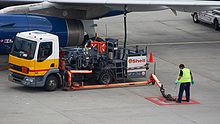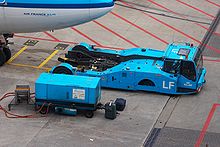Many airlines subcontract ground handling to airports, handling agents or even to another airline. According to the International Air Transport Association (IATA), conservative estimates indicate airlines outsource more than 50 per cent of the ground handling that takes place at the world's airports. Ground handling addresses the many service requirements of an airliner between the time it arrives at a terminal gate and the time it departs on its next flight. Speed, efficiency, and accuracy are important in ground handling services in order to minimize the turnaround time (the time during which the aircraft must remain parked at the gate).
Airlines with less-frequent service or fewer resources at a particular location sometimes subcontract ground handling or on-callaircraft maintenance to another airline, as it is a short-term cheaper alternative to setting up its own ground handling or maintenance capabilities.
Airlines may participate in an industry-standard Mutual Assistance Ground Service Agreement (MAGSA). The MAGSA is published by the Air Transport Association (the current version is from 1981) and is used by airlines to assess prices for maintenance and support to aircraft at so-called MAGSA Rates, which are updated annually based on changes in the U.S. Producer Price Index.[citation needed]Airlines may choose to contract for ground handling services under the terms of a Standard Ground Handling Agreement (SGHA) published in the International Air Transport Association (IATA) Airport Handling Manual.Airlines may also contract for ground handling services under non-standard terms.
Most ground services are not directly related to the actual flying of the aircraft, and instead involve other tasks. The major categories of ground handling services are described below.
Cabin service
The primary aim of this service offering is to ensure passenger comfort. While cabin cleaning comprises the bulk of the effort, it also includes tasks such as replenishing onboard consumables (soap, tissues, toilet paper, reading materials) and washable items like pillows and blankets.
Catering
Catering includes the unloading of unused food and drink from the aircraft, and the loading of fresh food and drink for passengers and crew. Airline meals are typically delivered in Airline service trolleys. Empty or trash-filled trolley from the previous flight are replaced with fresh ones. Meals are prepared mostly on the ground in order to minimize the amount of preparation (apart from chilling or reheating) required in the air.
While some airlines provide their own catering, others have either owned catering companies in the past and divested themselves of the companies, or have outsourced their catering to third-party companies. Airline catering sources include the following companies:
Airline Services & Logistics PLC(EPZE)
American Airlines
Atlas Catering (Royal Air Maroc's catering service)
Cara Operations
Cathay Pacific's Cathay Pacific Catering Services
Chelsea Food Services
Gate Gourmet
KLM's KLM Catering Services
LSG Sky Chefs
Q Catering (Qantas)
Servair
Thai Airways's Thai Catering Services
United Airlines
Ramp service

Luggage being unloaded from aNorthwest Airlines Boeing 757-200 at Amsterdam Airport Schiphol

A British Airways aircraft being refueled

Pushback tractor and a ground power
This includes services on the ramp or apron, such as:
Guiding the aircraft into and out of the parking position (by way of aircraft marshalling),
Towing with pushback tractors
Water cartage (typically non-potable for lavatory sink use)
Air conditioning (more common for smaller aircraft)
Airstart units (for starting engines)
Luggage handling, usually by means of beltloaders and baggage carts
Gate checked luggage, often handled on the tarmac as passengers disembark
Air cargo handling, usually by means of cargo dollies and cargo loaders
Catering trucks
Refueling, which may be done with a refueling tanker truck or refueling pumper
Ground power (so that engines need not be running to provide aircraft power on the ground)
Passenger stairs (used instead of an aerobridge or airstairs, some budget airlines use both to improve turnaround speed)
Wheelchair lifts, if required
Hydraulic mules (units that provide hydraulic power to an aircraft externally)
Deicing
Passenger service
This includes services inside the airport terminal such as:
Providing check-in counter services for the passengers departing on the customer airlines.
Providing gate arrival and departure services. The agents are required to meet a flight on arrival as well as provide departure services including boarding passengers and closing the flight.
Staffing the transfer counters, customer service counters and airline lounges.
Field operation service
This service dispatches the aircraft, maintains communication with the rest of the airline operation at the airport and with Air Traffic Control.
